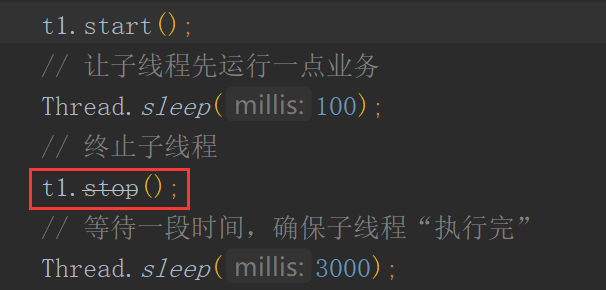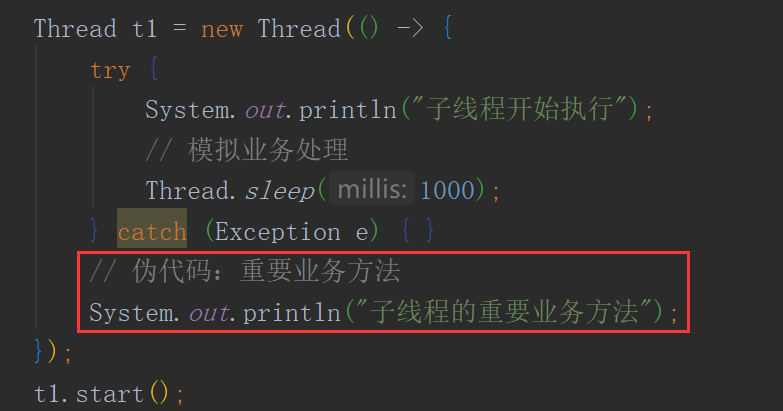這樣終止線程,竟然會導致服務宕機?
- 2020 年 4 月 6 日
- 筆記
在開始之前,我們先來看以下代碼會有什麼問題?
public class ThreadStopExample { public static void main(String[] args) throws InterruptedException { Thread t1 = new Thread(() -> { try { System.out.println("子線程開始執行"); // 模擬業務處理 Thread.sleep(1000); } catch (Exception e) { } // 偽代碼:重要的業務方法 System.out.println("子線程的重要業務方法"); }); t1.start(); // 讓子線程先運行一點業務 Thread.sleep(100); // 終止子線程 t1.stop(); // 等待一段時間,確保子線程「執行完」 Thread.sleep(3000); System.out.println("主線程執行完成"); } } 或許你已經發現了,上面這段代碼使用了 Thread.stop() 來終止線程,在 Java 程序中是不允許這樣終止線程的。什麼?你問為什麼不能這樣?
首先來說 IDE 都會鄙視你了,它會阻止你使用 Thread.stop() !
什麼?你不信。那麼來看這張圖:

好吧,那為什麼不能這樣用呢?總得給我一個敷衍的理由吧?
問題一:破壞了程序的完整性
其實是這樣的,以文章剛開頭的那段代碼來說,它的執行結果是:
子線程開始執行
主線程執行完成
我們發現了一個驚天的大問題,最重要的那段偽代碼竟然沒執行,如下圖所示:

可以看出使用 stop() 終止線程之後,線程剩餘的部分代碼會放棄執行,這樣會造成嚴重的且不易被發現的驚天大 Bug,假如沒有執行的那段代碼是釋放系統資源的代碼,或者是此程序的主要邏輯處理代碼。這就破壞了程序基本邏輯的完整性,導致意想不到的問題發生,而且它還很隱秘,不易被發現和修復。
有人說,這還不簡單,我加個 finally 不就完了嗎?
這???杠精哪都有,今年特別多。
行,既然這個說服不了你,咱接着往下看。
問題二:破壞了原子邏輯
我們知道在 Java 中 synchronized 屬於獨佔式可重入悲觀鎖,如果我們使用它修飾代碼,妥妥的多線程沒問題,但如果碰到 stop() 方法就不一定了,直接來看代碼吧。
public class ThreadStopExample { public static void main(String[] args) throws InterruptedException { MyThread myThread = new MyThread(); Thread t2 = new Thread(myThread); // 開啟線程 t2.start(); for (int i = 0; i < 10; i++) { Thread t = new Thread(myThread); t.start(); } // 結束線程 t2.stop(); } /** * 自定義原子測試線程 */ static class MyThread implements Runnable { // 計數器 int num = 0; @Override public void run() { // 同步代碼塊,保證原子操作 synchronized (MyThread.class) { // 自增 num++; try { // 線程休眠 0.1 秒 Thread.sleep(100); } catch (InterruptedException e) { e.printStackTrace(); } // 自減 num--; System.out.println(Thread.currentThread().getName() + " | num=" + num); } } } } 以上程序的執行結果為:
Thread-5 | num=1
Thread-4 | num=1
Thread-2 | num=1
Thread-1 | num=1
Thread-8 | num=1
Thread-6 | num=1
Thread-9 | num=1
Thread-3 | num=1
Thread-7 | num=1
Thread-10 | num=1
從結果可以看出,以上代碼經過 synchronized 修飾的 ++ 和 — 操作,到最後打印的結果 num 竟然不是 0,而是 1。
這是因為 stop() 方法會釋放此線程中的所有鎖,導致程序執行紊亂,破壞了程序的原子操作邏輯。
以上的這些問題,導致了 JDK 廢棄了 stop() 的方法,它的廢棄源碼如下:
/** * Forces the thread to stop executing. * <p> * If there is a security manager installed, its <code>checkAccess</code> * method is called with <code>this</code> * as its argument. This may result in a * <code>SecurityException</code> being raised (in the current thread). * <p> * If this thread is different from the current thread (that is, the current * thread is trying to stop a thread other than itself), the * security manager's <code>checkPermission</code> method (with a * <code>RuntimePermission("stopThread")</code> argument) is called in * addition. * Again, this may result in throwing a * <code>SecurityException</code> (in the current thread). * <p> * The thread represented by this thread is forced to stop whatever * it is doing abnormally and to throw a newly created * <code>ThreadDeath</code> object as an exception. * <p> * It is permitted to stop a thread that has not yet been started. * If the thread is eventually started, it immediately terminates. * <p> * An application should not normally try to catch * <code>ThreadDeath</code> unless it must do some extraordinary * cleanup operation (note that the throwing of * <code>ThreadDeath</code> causes <code>finally</code> clauses of * <code>try</code> statements to be executed before the thread * officially dies). If a <code>catch</code> clause catches a * <code>ThreadDeath</code> object, it is important to rethrow the * object so that the thread actually dies. * <p> * The top-level error handler that reacts to otherwise uncaught * exceptions does not print out a message or otherwise notify the * application if the uncaught exception is an instance of * <code>ThreadDeath</code>. * * @exception SecurityException if the current thread cannot * modify this thread. * @see #interrupt() * @see #checkAccess() * @see #run() * @see #start() * @see ThreadDeath * @see ThreadGroup#uncaughtException(Thread,Throwable) * @see SecurityManager#checkAccess(Thread) * @see SecurityManager#checkPermission * @deprecated This method is inherently unsafe. Stopping a thread with * Thread.stop causes it to unlock all of the monitors that it * has locked (as a natural consequence of the unchecked * <code>ThreadDeath</code> exception propagating up the stack). If * any of the objects previously protected by these monitors were in * an inconsistent state, the damaged objects become visible to * other threads, potentially resulting in arbitrary behavior. Many * uses of <code>stop</code> should be replaced by code that simply * modifies some variable to indicate that the target thread should * stop running. The target thread should check this variable * regularly, and return from its run method in an orderly fashion * if the variable indicates that it is to stop running. If the * target thread waits for long periods (on a condition variable, * for example), the <code>interrupt</code> method should be used to * interrupt the wait. * For more information, see * <a href="{@docRoot}/../technotes/guides/concurrency/threadPrimitiveDeprecation.html">Why * are Thread.stop, Thread.suspend and Thread.resume Deprecated?</a>. */ @Deprecated public final void stop() { SecurityManager security = System.getSecurityManager(); if (security != null) { checkAccess(); if (this != Thread.currentThread()) { security.checkPermission(SecurityConstants.STOP_THREAD_PERMISSION); } } // A zero status value corresponds to "NEW", it can't change to // not-NEW because we hold the lock. if (threadStatus != 0) { resume(); // Wake up thread if it was suspended; no-op otherwise } // The VM can handle all thread states stop0(new ThreadDeath()); } 可以看出 stop() 方法被 @Deprecated 注釋修飾了,而被此註解修飾的代碼表示為過時方法,不建議被使用。從 stop() 的備註信息可以看出,官方也不建議使用 stop() ,說它是一個非安全的方法。
正確終止線程
那如何終止線程呢?這裡提供 2 個正確的方法:
- 設置退出標識退出線程;
- 使用
interrupt()方法終止線程。
1.自定義退出標識
我們可以自定義一個布爾變量來標識是否需要退出線程,實現代碼如下:
// 自定義退出標識退出線程 static class FlagThread extends Thread { public volatile boolean exit = false; public void run() { while (!exit) { // 執行正常的業務邏輯 } } } 可以看出我們使用了關鍵字 volatile 對線程進行了修飾,這樣就可以保證多線程的執行安全了,在我們需要讓線程退出時,只需要把變量 exit 賦值為 true 就可以了。
2.interrupt 終止線程
當我們使用 interrupt() 方法時,以上兩個示例的執行結果就正常了,執行代碼如下:
public class ThreadStopExample { public static void main(String[] args) throws InterruptedException { // 問題一:破壞了程序的完整性 Thread t1 = new Thread(() -> { try { System.out.println("子線程開始執行"); // 模擬業務處理 Thread.sleep(1000); } catch (Exception e) { } // 偽代碼:重要業務方法 System.out.println("子線程的重要業務方法"); }); t1.start(); // 讓子線程先運行一點業務 Thread.sleep(100); // 終止子線程 t1.interrupt(); // 等待一段時間,確保子線程「執行完」 Thread.sleep(3000); System.out.println("主線程執行完成"); // 問題二:破壞了原子邏輯 MyThread myThread = new MyThread(); Thread t2 = new Thread(myThread); // 開啟線程 t2.start(); for (int i = 0; i < 10; i++) { Thread t = new Thread(myThread); t.start(); } // 結束線程 t2.interrupt(); } /** * 自定義原子測試線程 */ static class MyThread implements Runnable { // 計數器 int num = 0; @Override public void run() { // 同步代碼塊,保證原子操作 synchronized (MyThread.class) { // 自增 num++; try { // 線程休眠 0.1 秒 Thread.sleep(100); } catch (InterruptedException e) { System.out.println(e.getMessage()); } // 自減 num--; System.out.println(Thread.currentThread().getName() + " | num=" + num); } } } } 以上程序的執行結果為:
子線程開始執行
子線程的重要業務方法
主線程執行完成
sleep interrupted
Thread-1 | num=0
Thread-9 | num=0
Thread-10 | num=0
Thread-7 | num=0
Thread-6 | num=0
Thread-5 | num=0
Thread-4 | num=0
Thread-2 | num=0
Thread-3 | num=0
Thread-11 | num=0
Thread-8 | num=0
可以看出以上的執行都符合我們的預期,這才是正確的終止線程的方式。
總結
本文我們講了線程的三種終止方式,自定義退出標識的方式、使用 stop() 的方式或 interrupt() 的方式。其中 stop() 的方式會導致程序的完整性和原子性被破壞的問題,並且此方法被 JDK 標識為過期方法,不建議使用,而 interrupt() 方法無疑是最適合我們的終止線程的方式。

